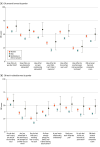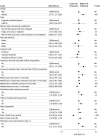Burnout Among Mid-Career Academic Medical Faculty
- PMID: 38857049
- PMCID: PMC11165383
- DOI: 10.1001/jamanetworkopen.2024.15593
Burnout Among Mid-Career Academic Medical Faculty
Abstract
Importance: Studies reveal that most physicians report symptoms of burnout. Less is known about burnout in mid-career medical faculty specifically.
Objective: To characterize burnout and its risk factors, particularly differences by gender, among mid-career medical faculty.
Design, setting, and participants: Between August 2021 and August 2022, a survey was sent to 1430 individuals who received new National Institutes of Health K08 and K23 career development awards from 2006 to 2009. Data were analyzed between June and October 2023.
Main outcomes and measures: Personal and work-related burnout as evaluated using the Copenhagen Burnout Inventory (CBI). The CBI score ranges from 0 to 100, with a score of 50 or higher indicating a high degree of burnout. Multivariable models were used to investigate associations between burnout and participant characteristics, including race and ethnicity, sexual orientation and gender identity, academic rank, work climate, experiences of workplace sexual harassment, sleep hours, work and domestic caregiving time, and time allocation changes in work and domestic work hours compared with before the COVID-19 pandemic. Work climate was evaluated by a general climate elements scale assessing elements such as friendliness, respect, and collegiality, and a diversity, equity, and inclusion climate elements scale assessing elements such as homogeneity, sexism, and homophobia; higher scores indicated a more favorable view of the climate.
Results: In all, 1430 surveys were sent, 926 candidates responded (65% response rate), and the analytic cohort was limited to the 841 respondents who were still in academic medicine (50.7% men). Burnout was significantly more common for women than men (mean [SD] CBI personal scores, 46.6 [19.4] vs 37.5 [17.2]; P < .001; mean [SD] CBI work-related scores, 43.7 [20.4] vs 34.6 [19.7]; P < .001). In multivariable models, personal burnout was significantly more likely for women (adjusted odds ratio [AOR], 2.29 [95% CI, 1.54-3.41]; P < .001) and with more weekly hours of patient care (AOR, 1.07 [95% CI, 1.00-1.15] for each 5-hour increase; P = .04). Personal burnout was less likely with more nightly sleep hours (AOR, 0.68 [95% CI, 0.56-0.81] for each 1-hour increase; P < .001) and with an improved general work climate rating (AOR, 0.64 [95% CI, 0.48-0.85] for each 1-point increase in general work climate scale score; P = .002). Work-related burnout was also significantly more likely for women than men (AOR, 1.77 [95% CI, 1.17-2.69]; P = .007). Greater work-related burnout was associated with an increase of 8 or more work hours per week compared with before the COVID-19 pandemic (AOR, 1.87 [95% CI, 1.13-3.08]; P = .01), more weekly hours of patient care (AOR, 1.11 [95% CI, 1.03-1.19] for each 5-hour increase; P = .007), and a workplace sexual harassment experience in the past 2 years (AOR, 1.71 [95% CI, 1.11-2.62]; P = .01). Work-related burnout was significantly less likely with more nightly sleep hours (AOR, 0.80 [95% CI, 0.66-0.96] for each 1-hour increase; P = .02) and with an improved general work climate rating (AOR, 0.49; [95% CI, 0.36-0.65] for each 1-point increase in general work climate scale score; P < .001).
Conclusions and relevance: This survey study of K grant awardees revealed substantial rates of burnout among mid-career medical faculty, and burnout rates differed by gender. Evidence-based interventions are needed to realize the benefits of workforce diversity and vitality.
Conflict of interest statement
Figures



Similar articles
-
Workplace Harassment, Cyber Incivility, and Climate in Academic Medicine.JAMA. 2023 Jun 6;329(21):1848-1858. doi: 10.1001/jama.2023.7232. JAMA. 2023. PMID: 37278814 Free PMC article.
-
The Disproportionate Effects of the COVID-19 Pandemic on the Time Allocation of Recipients of NIH Career Development Awards Who Are Women or Caregivers of Dependents.Acad Med. 2024 Dec 1;99(12):1396-1404. doi: 10.1097/ACM.0000000000005681. Epub 2024 Mar 7. Acad Med. 2024. PMID: 38452218
-
Is Grit Associated with Burnout and Well-being in Orthopaedic Resident and Faculty Physicians? A Multi-institution Longitudinal Study Across Training Levels.Clin Orthop Relat Res. 2021 Dec 1;479(12):2576-2586. doi: 10.1097/CORR.0000000000001987. Clin Orthop Relat Res. 2021. PMID: 34587147 Free PMC article.
-
Association of Characteristics of the Learning Environment and US Medical Student Burnout, Empathy, and Career Regret.JAMA Netw Open. 2021 Aug 2;4(8):e2119110. doi: 10.1001/jamanetworkopen.2021.19110. JAMA Netw Open. 2021. PMID: 34369990 Free PMC article.
-
Toward better prevention of physician burnout: insights from individual participant data using the MD-specific Occupational Stressor Index and organizational interventions.Front Public Health. 2025 Mar 19;13:1514706. doi: 10.3389/fpubh.2025.1514706. eCollection 2025. Front Public Health. 2025. PMID: 40177083 Free PMC article.
Cited by
-
Different artificial neural networks for predicting burnout risk in Italian anesthesiologists.J Anesth Analg Crit Care. 2025 Jul 1;5(1):40. doi: 10.1186/s44158-025-00255-w. J Anesth Analg Crit Care. 2025. PMID: 40597440 Free PMC article.
-
Gender and Career Milestones of Mid-Career to Senior Medical Faculty Who Held Career Development Awards.JAMA Intern Med. 2025 Jul 1;185(7):890-893. doi: 10.1001/jamainternmed.2025.1059. JAMA Intern Med. 2025. PMID: 40388138
-
Beyond misconduct: forging an ethical future in academia.Can J Anaesth. 2025 Jul 14. doi: 10.1007/s12630-025-03021-2. Online ahead of print. Can J Anaesth. 2025. PMID: 40659920 No abstract available.
-
Is the Medical Oncology Workforce in Canada in Jeopardy? Findings from the Canadian Association of Medical Oncologists' COVID-19 Impact Survey Series.Curr Oncol. 2024 Jul 27;31(8):4284-4291. doi: 10.3390/curroncol31080319. Curr Oncol. 2024. PMID: 39195302 Free PMC article.
References
-
- National Academies of Sciences, Engineering, and Medicine; National Academy of Medicine; Committee on Systems Approaches to Improve Patient Care by Supporting Clinician Well-Being . Taking Action Against Clinician Burnout: A Systems Approach To Professional Well-Being. National Academies Press; 2019. - PubMed
-
- Templeton K, Bernstein CA, Sukhera J, et al. . Gender-based differences in burnout: issues faced by women physicians. NAM Perspect. Published online May 30, 2019. doi:10.31478/201905a. - DOI
-
- National Academies of Medicine . National Plan for Health Workforce Well-Being. The National Academies Press; 2022.
Publication types
MeSH terms
Grants and funding
LinkOut - more resources
Full Text Sources
Medical
Miscellaneous

